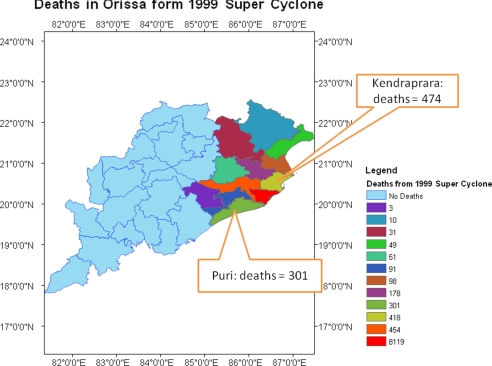Das and Vincent (1) conclude that mangroves reduced the death toll from storm surge in the Orissa Super Cyclone. However, it is unclear from their analyses whether or not this effect occurs independently over and above that of other variables known to affect inundation by long-period waves, such as distance from the coast and topography (2). Further, Das and Vincent (1) are wrong to equate storm surges with wind-generated storm waves. Storm surges have a period of hours to days (3) and consequently behave more like the tide or a tsunami. An effect of vegetation has never been questioned (2). The drag of vegetation must reduce wave velocity to some degree. More important questions, however, are how much protection vegetation can provide and how this compares with other mitigating factors (2). The results suggest that mangroves offered little protection (1). The correlation coefficient (r = −0.13) between mangrove width and village deaths suggests that mangroves explain less than 2% of the variation in deaths. Clearly, other factors were also important. The study site covers only the northern extreme of the area affected by the cyclone and only 254 of >10,000 deaths occurred here. When the total area is considered, there is clear aggregation of deaths, which were much higher closer to where the storm crossed the coast (Fig. 1). Presumably, village proximity to the storm center or other variables such as distance from the coast and height above sea level were more important than mangroves in determining deaths per village. Indeed, these last two variables are significant whenever included in the models. Why then the emphasis on mangroves when no formal methods of model selection were used (4)?
Fig. 1.
Human deaths by district from the Orissa Super Cyclone (6, 7).
Even accepting the results, do they indicate that mangroves can provide an effective shield against storm surges, as suggested by the Food and Agriculture Organization? Surge-related deaths were recorded in villages >2 km inland (1), suggesting the vegetation barrier will need to be very wide in similar low-lying areas. Indeed, in areas where high ground occurs close to the coast, the effect of vegetation is unlikely to be detectable (2). Finally, is revegetation an economical option for disaster mitigation? The authors estimate an opportunity cost of $300,000 (US) for every hectare of mangrove not cleared for farming. In contrast, the cost of an early warning system is minimal, because the existing weather forecasting capacity was sufficient to issue a warning that saved ≈5 lives per village (1). We conclude that although mangroves may have reduced deaths in this event (1), the effect is likely to be small, particularly when compared to other variables. Furthermore, the cost of revegetation is high and the effectiveness of a mangrove barrier is low when compared to an early warning system. The value in conserving coastal forests is preventing occupation of the most dangerous areas, which are close to the coast in low-lying areas (5).
Footnotes
The authors declare no conflict of interest.
References
- 1.Das S, Vincent JR. Mangroves protected villages and reduced death toll during Indian super cyclone. Proc Natl Acad Sci USA. 2009;106:7357–7360. doi: 10.1073/pnas.0810440106. [DOI] [PMC free article] [PubMed] [Google Scholar]
- 2.Kerr AM, Baird AH. Natural barriers to natural disasters. Bioscience. 2007;57:102–103. [Google Scholar]
- 3.Storch H, Woth K. Storm surges, perspectives and options. Sust Sci. 2008;3:33–43. [Google Scholar]
- 4.Burnham KP, Anderson DR. Model Selection and Multi-Model Inference: A Practical Information-Theoretic Approach. Heidleberg: Springer; 2002. [Google Scholar]
- 5.Feagin RA, et al. Does vegetation prevent wave erosion of salt marsh edges? Proc Natl Acad Sci USA. 2009;106:10109–10113. doi: 10.1073/pnas.0901297106. [DOI] [PMC free article] [PubMed] [Google Scholar]
- 6.Orissa Super Cyclone Situation Report 8. [Accessed August 3, 2009]. Available at www.reliefweb.int/rw/rwb.nsf/db900SID/OCHA-64DK8G?OpenDocument.
- 7.Census of India, District Profiles– Education, 2001. [Accessed August 3, 2009]. Available at http://finder.geocommons.com/overlays/4383.



